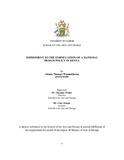| dc.description.abstract | Design translates abstract thoughts of researchers, scientists and technologists into tangible
products and services that meet specific public needs. Design forms the initial stage of any
production processes and it therefore has great potential to influence job creation which lead
to faster social economic development. Industrialized and industrializing countries embrace
design in their policies. Their design industry has grown equally because of the
appropriateness of the underlying national design policy.
In Kenya, Policy makers benchmark with industrializing countries in Asia and often
recognize that innovation contributes to rapid economic growth. However, during public
policy formulation, design is not emphasized as key element of innovation. The government
has had no attempt to formulate national design policy to alleviate this setback. This forms
the impetus on which this project was sets out to: i) understand the current policies of design
in Kenya ii) recommend the national design institutional structure, and iii) propose a National
Design Policy formulation process.
Research findings show that suppressive design policies carried on from colonial era still
influence post-colonial design industry. Attempts to formulate public policies to improve
innovation standards have not been successful. Design is loosely hinged to science and
technology where it loses its significance. Design policies are uncoordinated and scattered in
various policy documents and responsibility falls under various institutions. The following
impeding factors to national design policy formulation are: Policy makers lack knowledge on
design values to the country; most public policies do not attract and exploit the potential of
local design industry; the public and private sector design initiatives are not appropriately
linked; lack of national oversight body to streamline and set design standards; inappropriate
design education; design industry alienation to policy organisations and the public.
These studies recommend a creation of a national design policy to enhance design standards
envisaged in Vision 2030’s. The proposed design policy will leverage the potential of
regional designs derived from devolved county governments in the Kenya. | en_US |

